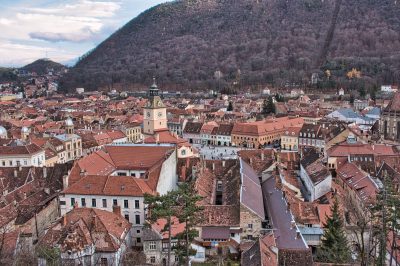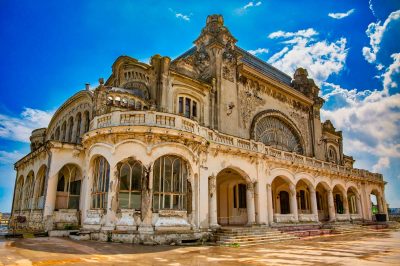Today we take you to the west of Romania, more precisely to Transylvania. Here lies the city of Alba Iulia, which has a population of around 60,000 and is called Karlsburg in German and Gyulafehérvár in Hungarian. But why are we looking at this medium-sized town, which many in the West may never have heard of? Quite simply, because Alba Iulia has not only been inhabited since ancient times, but also because here you can explore an almost completely preserved old town with the Alba Iulia Citadel, unique in its fortress character. So, let’s go to Transylvania, but first let’s have a look at the past of this historical place!

The history of Alba Iulia
The roots of Alba Iulia go back to ancient times. Roman troops conquered a settlement of the Dacian people called Apoulon here and transformed it into an army camp, the remains of which can still be seen today. With the fall of the Roman Empire also came the rise of the horse-riding Avars, who conquered the settlement and renamed it Balgrad, the White City, because of its white walls (the name of the Serbian capital is also derived from it). And even today Alba Iulia bears the name white city, because that is the name in Romanian.
Destruction and time as the capital
In the Middle Ages the city was destroyed by Tartars and about 300 years later it was conquered by Mihai Viteazul. Then, in 1599, the city acquired outstanding importance when Mihai Viteazul declared it the capital of the Union of the three principalities of Moldavia, Wallachia and Transylvania. Thus, a precursor state of today’s Romania was set in motion.
Ottomans and Austrians
Subsequently, Alba Iulia was destroyed several times and taken by the Ottomans. Austria succeeded in conquering Alba Iulia and the town, now called Karlsburg, reached a hitherto unknown prosperity in the 17th and 18th centuries. In order to protect the many splendid buildings of that time, a mighty defense system was built, which still exists today in the form of a star-shaped fortress and gives Alba Iulia its unmistakable character.
A modern state emerges
Alba Iulia was then of outstanding historical importance at the end of the First World War. The Austro-Hungarian Dual Monarchy was down, and so a Romanian National Assembly met here, during which several previously Hungarian territories (including Banat and Transylvania) were annexed to Romania. Several places in the city commemorate this event, as you will see in a moment. Since then, Alba Iulia has been part of Romania and today it is more beautiful than ever.

Sights in the Alba Iulia Citadel
But enough of the preface, let’s go to Alba Iulia or Karlsburg! This is our top 10 most beautiful sights in the city.
Alba Carolina
The Alba Carolina Citadel is the “defense star” that today frames the old town. It was built in the early 18th century and has survived until today. Here, in the area of conflict between Austria and the Ottoman Empire, the Austrians built it into an impregnable fortress, just as they did in other Romanian cities. At times, countless soldiers lived here, yet Karlsburg was able to develop magnificently at that time. The following sights are almost all located inside the citadel. During a visit you should not only go to these points, but simply drift through the historical scenery and enjoy the magic of Alba Iulia.

St. Micheal’s Cathedral
St. Michael’s Cathedral is considered one of the most important Catholic churches in Romania. It is the seat of the Archbishop of Alba Iulia and has stood here almost unchanged since the 13th century. Only some frescoes, a chapel and choir stalls were added during the Renaissance. The building may look a bit out of round from the outside. This is due to the fact that the church was supposed to have a second tower, but unfortunately there was no money left for it. However, the highly Gothic interior compensates for this “flaw”. Romanesque reliefs, a Pietà depiction and a wonderful organ are worth seeing, as are the tombs of important rulers, including those of the Hungarian Queen Isabella Jagiellonica, who came from Krakow, and Johann Sigismund Zápolya.
The history of the cathedral is also interesting, as it became Calvinist in the course of the Reformation and was not recatholicized until the Habsburgs came to power. In order to be able to counter this Catholic place of worship also in spiritual terms, the Coronation Cathedral was built right next to it after the First World War.

Coronation Cathedral
The Coronation Cathedral in Alba Iulia is also known as the Trinity Cathedral and the Cathedral of the Reunion and is today the dominant building in Alba Carolina. Through a bell tower almost 60 meters high, you will reach the interior of an arcaded courtyard where ancient findings are exhibited. The beautiful paintings here are not to be missed!
Then in the center of the courtyard rises the mighty neo-Byzantine Coronation Cathedral with its domes. It was built in the 1920s. After Transylvania became part of Romania after World War I (what is called reunification in Romania), this was the ideal place for a place of worship to commemorate the historical event, after all, it was in Alba Iulia that reunification was decided. The church is named Coronation Cathedral because it was here that Ferdinand I and Marie were crowned King and Queen of Romania in 1922. Moreover, the unification of the Uniate and Romanian Orthodox Churches took place here in 1948.
Prince’s Palace
The Palatul Princiar is perhaps not the most spectacular building of Alba Iulia, but one of great historical importance. The complex of over 60 rooms is grouped around two courtyards and was once the seat of the princes of Transylvania, including Michael the Brave (Mihai Viteazul). He is considered a national hero in Romania, as he was the first to unite (albeit for only a few months) the three historical principalities of Transylvania, Wallachia and Moldavia, and is thus considered by many to be the pioneer of the modern Romanian nation-state. Originally, the Prince’s Palace was a magnificent building, but it was later plundered by Tartars and Turks and then used as barracks by the Austrians, which of course did not leave no trace on the building.

In front of the palace is a monumental memorial to Michael the Brave. Here, on horseback, he stretches his scepter into the sky in a sublime gesture, accompanied only by a few pigeons and the people who sit here at the tables of the vending carts and drink a coffee.
Apor Palace
In the north of the Old Town stands the Apor Palace, which is now the seat of the Rector of the University. It bears the name of its former owner, Prince Ştefan Apor, and was the first Baroque secular building in Transylvania. Apor was succeeded by the Austrian troop commander Count Steinville, who found a residence here befitting his status. Under Austrian rule, the palace was heavily rebuilt, and the communists turned it into an administrative building for a peasant cooperative. And so now the rector of the university “1 Decembrie 1918″ is the new master of the estate. But you can still visit it, there is even a small archaeological exhibition in the basement.

Museum of National Unity
The Museum of National Unity sounds at first like a political history museum with a patriotic exhibition. But in fact, one of the most interesting archaeological exhibitions of the region is displayed here, and has been since the end of the 19th century. The building houses numerous finds from the Bronze Age, but also from other periods such as antiquity, thus illustrating the rich past of the region. However, the National Assembly also met in the historic halls to decide the union of Transylvania with Romania, which is of course also commemorated. You can visit the so-called “Hall of Unity” for free, for the museum a small entrance fee is charged. The visit is also worthwhile because the museum received a facelift on the occasion of the 100th anniversary of the Union in 2018 and now presents itself extremely modern.

Synagogue
Alba Iulia is home to the oldest Jewish community in Transylvania and also boasts the oldest brick synagogue in the country. It was built in the middle of the 19th century and has elements of neo-baroque and neo-classicism. To this day, you can spot three cannonballs on the facade that were fired at the synagogue during the 1848/49 revolution and got stuck in the brickwork. Interesting structural detail: the synagogue has a small prison, where presumably people were briefly detained who did not follow certain religious rules. Since the Alba Iulia community is relatively small, services are held here today only on high holidays.
Biblioteca Batthyaneum
Today, the Biblioteca Batthyaneum contains over 70,000 volumes. It was established as early as 1780 and goes back to Bishop Bathyani, who created a haven of knowledge here. The library is housed in a former monastery, which was initially converted into a military hospital under Emperor Joseph II. The library even had its own observatory and printing press. Among the treasures of the institution are magnificently illustrated medieval Bibles and many other historical books.

Castrum
You can see for yourself that the Romans left their traces also in Alba Iulia in the Apulum Fort. It is the largest castrum (military camp) on Romanian soil, built in the 2nd century A.D. and occupying an area of almost 40 hectares. Parts of the complex have been reconstructed, giving you an idea of the size of the camp at that time and the Roman architecture. However, most of the finds that archaeologists made here are exhibited in the Museum of National Unity.
Unity Park
Parcul Unirii is located west of the fortress and is one of the few places worth seeing outside the old town. This is mainly due to its huge fountain, in which from several unusual steel structures are let into the basin. Like sunbeams, several wide walkways run from im in all directions and you can relax here perfectly after exploring Carlsbad.
Accommodation
- Hotel Medieval*. The Medieval is housed in the former commissariat and combines the comfort of a modern hotel with the quaint flair of historic premises.
- Hotel Cetate Imparatul Romanilor*. The “Cetate” is not exactly the most beautiful house in town, but it has the unbeatable advantage of being housed in a tall building with a beautiful view just below the citadel.
Book recommendations
This classic tour guide covers Romania and the neighbouring Bulgaria in all of its beauty
No products found.
This book contains the latest research on the history of Banat in Romania
No products found.
This well written books tells you everything you need to know about Romania’s troubled history.
No products found.



